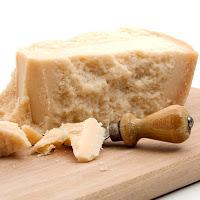 I’m writing this post under duress. Not duress, exactly, but under orders.
I’m writing this post under duress. Not duress, exactly, but under orders.There’s a woman in Rome who’s been my student for the past ten years. We meet weekly just to talk, to help keep her English speaking skills honed. Last week, I checked the time just as I rang the bell and was horrified to discover that I was an hour early. When she opened the door, I offered to go away for an hour, but she ushered me into the kitchen. “I’m cooking,” she said and steered me to a chair.
Strictly speaking, she wasn’t cooking. She was preparing pesto. As she stripped the basil
 leaves from the stalks and chunked the Parmigiano-Reggiano, I had a ringside seat. We chatted as we do about this and that. When she finished, I got to sample the finished product. And she said to me, “When you put this in your blog, you have to say it’s Olimpia Pallavicino’s recipe—not yours.” And so it is.
leaves from the stalks and chunked the Parmigiano-Reggiano, I had a ringside seat. We chatted as we do about this and that. When she finished, I got to sample the finished product. And she said to me, “When you put this in your blog, you have to say it’s Olimpia Pallavicino’s recipe—not yours.” And so it is.Olimpia didn’t measure anything; she just prepared it by instinct. I’ve tried to standardize the recipe, using American measurements (with metric equivalents in parentheses).
 Pesto Milanese
Pesto Milanese2 cups basil leaves, lightly packed. Olimpia used the leaves from three stems.1/3 cup pine nuts (40 grams) Olimpia stressed that you must use the best pine nuts you can find.1/2 cup grated Parmigiano-Reggiano (45 grams)1/2 to 2/3 cup extra virgin olive oil (120-160 ml)1 clove garlic (optional) Olimpia omitted the garlic.
 Place all the ingredients in a food processor and process until smooth. Olimpia did not grate the cheese. Instead she added it in chunks. She used a blender, and it took a while for the cheese to be completely pulverized. As a result, the pesto was very smooth.
Place all the ingredients in a food processor and process until smooth. Olimpia did not grate the cheese. Instead she added it in chunks. She used a blender, and it took a while for the cheese to be completely pulverized. As a result, the pesto was very smooth.Olimpia planned to serve the pesto with rice that evening, but for pasta she recommended using fusilli because there are so many nooks and crannies for the pesto to cling to.
